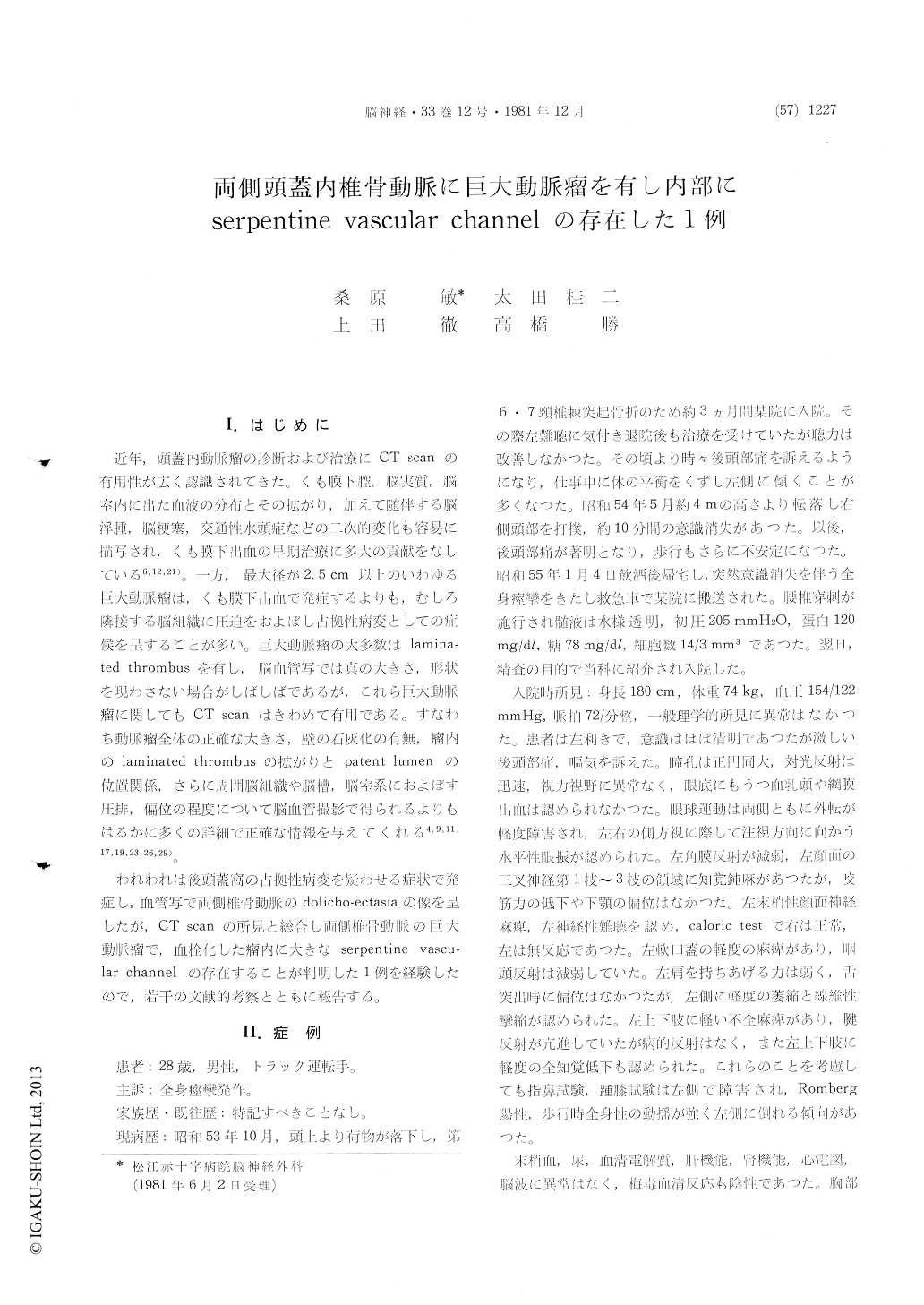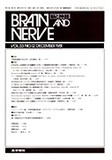Japanese
English
- 有料閲覧
- Abstract 文献概要
- 1ページ目 Look Inside
I.はじめに
近年,頭蓋内動脈瘤の診断および治療にCT scanの有用性が広く認識されてきた。くも膜下腔,脳実質,脳室内に出た血液の分布とその拡がり,加えて随伴する脳浮腫,脳梗塞,交通性水頭症などの二次的変化も容易に描写され,くも膜下出血の早期治療に多大の貢献をなしている6,12,21)一方,最大径が2.5cm以上上のいわゆる巨大動脈瘤は,くも膜下出血で発症するよりも,むしろ隣接する脳組織に圧迫をおよぼし占拠性病変としての症候を呈することが多い。巨大動脈瘤の大多数はlamina—ted thrombusを有し,脳血管写では真の大きさ,形状を現わさない場合がしばしばであるが,これら巨大動脈瘤に関してもCT scanはきわめて有用である。すなわち動脈瘤全体の正確な大きさ,壁の石灰化の有無,瘤内のlaminated thrombusの拡がりとpatent lumenの位置関係,さらに周囲脳組織や脳槽,脳室系におよぼす圧排,偏位の程度について脳血管撮影で得られるよりもはるかに多くの詳細で正確な情報を与えてくれる4,9,11,17,19,23,26,29)。
われわれは後頭蓋窩の占拠性病変を疑わせる症状で発症し,血管写で両側椎骨動脈のdolicho-ectasiaの像を呈したが,CT scanの所見と総合し両側椎骨動脈の巨大動脈瘤で,血栓化した瘤内に大きなserpentine vascu—lar channelの存在することが判明した1例を経験したので,若干の文献的考察とともに報告する。
Giant intracranial aneurysms of the vertebro-basilar system could be mistakenly diagnosed as neoplasms of the posterior fossa, on the basis of their clinical presentation. This report emphasizes the complementary value of angiography and com-puted tomography for the localization and correct diagnosis of giant aneurysms of the posterior fossa.
A 28-year-old man was admitted to Matsue Red Cross Hospital on January 5, 1980, because of a sudden generalized convulsion. He had a 1 year history of intermittent occipital headache, hearing loss in the left ear and balance disturbance. Since 7 months before admission, these symptoms had become progressively worse and at times were as-sociated with nausea and vomiting.
Neurological examination revealed horizontal nystagmus on lateral gaze to the both sides, diminu-tion of the left corneal reflex, left peripheral facial palsy and loss of hearing in the left ear. Pharyn-geal reflex was reduced on the left and the strength of the left sternocleidomastoid muscle was dimini-shed. The tongue did not deviate but the left side was wasted. He had a left hemiparesis and the limbs on the left showed a mild hyperrellexia and an increased tonus. There were no pathologic reflexes. Although a hemiparesis was taken into consideration, finger-to-nose test and heel-to-knee test were disturbed on the left and a tendency to fall to the left was observed. There was decreased sensory response to all modalities on the left.
Plain skull films and EEG were normal. The CSF was clear, under an initial pressure of 205mmH2O, and protein content was 120mg/dl. Plain CT scan demonstrated a large oval nonhomogeneous lesion of high density in the left half of the posterior fossa. A round high density mass was also shown along the right pyramid. There were associated with moderate hydrocephalus and compression of the fourth ventricle. CT scan with contrast revealed moderate enhancement of the rim of the bilateral masses and a band-like area of markedly increased density crossing each mass from the lower right to the upper left. Vertebral angiography showed that the bilateral vertebral arteries were markedly tortuous, elongated, dilated and curved from the right to the left in A-P views. In lateral views the dilated vertebral arteries formed dorsally con-vex archs and were displaced backwards from the cliv us.
Compared the CT findings with the angiogram, it was presumed that the well circumscribed round masses on CT were giant vertebral aneurysms on both sides containing thick thrombus and the band-like areas of increased density were patent vascular channels crossing these aneurysms, which were the lumen of the tortuous vertebral arteries.
Because of the extreme difficulty of direct attack on the aneurysms or of vertebral ligation, ventri-culo-peritoneal shunt operation was performed to relieve hydrocephalus. Postoperative examination revealed an improvement of the left hemiparesis, hemisensory disturbance and cerebellar dysfunction, while the fifth to twelfth left cranial nerve lesions persisted.
Many of the giant aneurysms contain a large amount of clot and therefore their full extent may not be demonstrated by angiography. Angiography may even give the appearance of an ectatic vessel due to a residual channel through the clot-filled aneurysm as in our case. CT scan provides precise information concerning the actual size and location of large but partially thrombosed or calcified giant aneurysm to better advantage than angiography. The angiographic and CT findings are, therefore, complementary and both studies are needed.

Copyright © 1981, Igaku-Shoin Ltd. All rights reserved.


